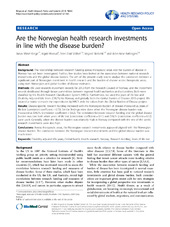| dc.contributor.author | Kinge, Jonas Minet | en_US |
| dc.contributor.author | Roxrud, Ingrid | en_US |
| dc.contributor.author | Vollset, Stein Emil | en_US |
| dc.contributor.author | Skirbekk, Vegard | en_US |
| dc.contributor.author | Røttingen, John-Arne | en_US |
| dc.date.accessioned | 2015-01-07T11:56:12Z | |
| dc.date.available | 2015-01-07T11:56:12Z | |
| dc.date.issued | 2014-11-27 | eng |
| dc.Published | . 2014 Nov 27;12(1):64 | en_US |
| dc.identifier.issn | 1478-4505 | |
| dc.identifier.uri | https://hdl.handle.net/1956/9082 | |
| dc.description.abstract | Background: The relationship between research funding across therapeutic areas and the burden of disease in Norway has not been investigated. Further, few studies have looked at the association between national research investments and the global disease burden. The aim of the present study was to analyze the correlation between a significant part of Norwegian investment in health research and the burden of disease across therapeutic areas, using both Norwegian and global burden of disease estimates. Methods: We used research investment records for 2012 from the Research Council of Norway, and the investment records distributed through liaison committees between regional health authorities and universities. Both were classified by the Health Research Classification System (HRCS). Furthermore, we used the years of life lost and Disability Adjusted Life Years (DALYs) for Norway and globally from the Global Burden of Disease 2010 project. We created a matrix to match the expenditures by HRCS with the values from the Global Burden of Disease project. Results: Disease-specific research funding increased with the Norwegian burden of disease measured as years of life lost (correlation coefficient = 0.73). Similar findings were done when the Norwegian disease burden was measured as DALYs (correlation coefficient = 0.62). The correlation between research funding and the global disease burden was low both when years of life lost (correlation coefficient = 0.11) and DALYs (correlation coefficient = 0.12) were used. Generally, when the disease burden was relatively high in Norway compared with the rest of the world, research investments were also high. Conclusions: Across therapeutic areas, the Norwegian research investments appeared aligned with the Norwegian disease burden. The correlation between the Norwegian research investments and the global disease burden was much lower. | en_US |
| dc.language.iso | eng | eng |
| dc.publisher | BioMed Central | eng |
| dc.rights | Attribution CC BY | eng |
| dc.rights.uri | http://creativecommons.org/licenses/by/4.0 | eng |
| dc.subject | Disability adjusted life years | eng |
| dc.subject | Global health | eng |
| dc.subject | Health research | eng |
| dc.subject | Norway | eng |
| dc.subject | Research funding | eng |
| dc.subject | Years of life lost | eng |
| dc.title | Are the Norwegian health research investments in line with the disease burden? | en_US |
| dc.type | Peer reviewed | |
| dc.type | Journal article | |
| dc.date.updated | 2014-12-02T20:03:55Z | |
| dc.description.version | publishedVersion | en_US |
| dc.rights.holder | Copyright 2014 Kinge et al.; licensee BioMed Central Ltd | |
| dc.rights.holder | Jonas Minet Kinge et al.; licensee BioMed Central Ltd. | |
| dc.source.articlenumber | 64 | |
| dc.identifier.doi | https://doi.org/10.1186/1478-4505-12-64 | |
| dc.identifier.cristin | 1202846 | |
| dc.source.journal | Health Research Policy and Systems | |
| dc.source.40 | 12 | |
| dc.source.14 | 1 | |

